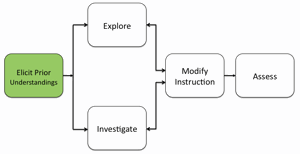Energy Concept Map
Students will be introduced to sources of energy (sun, moon, and earth) using a graphical representation. Students will then be introduced to potential and kinetic forms of energy.

1. Ask students to look around the classroom and point out things that are using energy (for example, computer, clock, lights, plants, watch, themselves). Ask students to write in their journals where each item gets its energy and how it uses it. (For example, a computer gets its energy from electricity and uses it to perform computing tasks). Discuss student responses aloud.
2. Show students the Energy Terms video clip. We recommend that you download the file (energy_terms.mov) from the Web site and play locally on your computer at double size.
3. Inform students that they will learn about the main sources and forms of energy.
4. Instruct students to download the Energy Concept Map from the student resources page. Use an LCD projector to display the Energy Concept Map at the front of the room.
5. Have students complete what they know on the concept map and submit it electronically. (Alternatively, you may wish to print out the concept map and have students complete it and return a hard copy to you). The concept maps will be compared to the students' final concept maps at the end of the unit. This will serve as an assessment measure of students' understandings of the relationships among energy sources.
Implementation suggestion:
- You may wish to have students add to this concept map periodically throughout the unit. At the end of the unit, the students' concept maps should be quite detailed with many associations made among different energy concepts. View a completed end-of-the-unit concept map.
6. Using the Energy Concept Map, explain to students the three main sources of energy (sun, moon, and Earth). This serves as a "big picture" overview of the energy sources that will be explored in the unit.
7. Explain to students potential and kinetic forms of energy. Give some examples of each.
8. Ask students to give other examples of kinetic and potential energy. Provide feedback.
9. Review the main sources of energy and forms of energy.
10. Ask students if they have any questions about concepts covered in the lesson and respond to their questions.
2. Show students the Energy Terms video clip. We recommend that you download the file (energy_terms.mov) from the Web site and play locally on your computer at double size.
3. Inform students that they will learn about the main sources and forms of energy.
4. Instruct students to download the Energy Concept Map from the student resources page. Use an LCD projector to display the Energy Concept Map at the front of the room.
5. Have students complete what they know on the concept map and submit it electronically. (Alternatively, you may wish to print out the concept map and have students complete it and return a hard copy to you). The concept maps will be compared to the students' final concept maps at the end of the unit. This will serve as an assessment measure of students' understandings of the relationships among energy sources.
Implementation suggestion:
- You may wish to have students add to this concept map periodically throughout the unit. At the end of the unit, the students' concept maps should be quite detailed with many associations made among different energy concepts. View a completed end-of-the-unit concept map.
6. Using the Energy Concept Map, explain to students the three main sources of energy (sun, moon, and Earth). This serves as a "big picture" overview of the energy sources that will be explored in the unit.
7. Explain to students potential and kinetic forms of energy. Give some examples of each.
8. Ask students to give other examples of kinetic and potential energy. Provide feedback.
9. Review the main sources of energy and forms of energy.
10. Ask students if they have any questions about concepts covered in the lesson and respond to their questions.
11. Provide guiding, reflective questions for students to respond in their journals what they have learned so far about energy, energy terms, and the energy audit activity.
Materials Needed:
Video
Energy Terms Video Clip (QuickTime video)
Concept Map
Energy Concept Map (Inspiration / JPEG)
Teacher Resources/Content Support
Energy Basics - Print Version (PDF)
